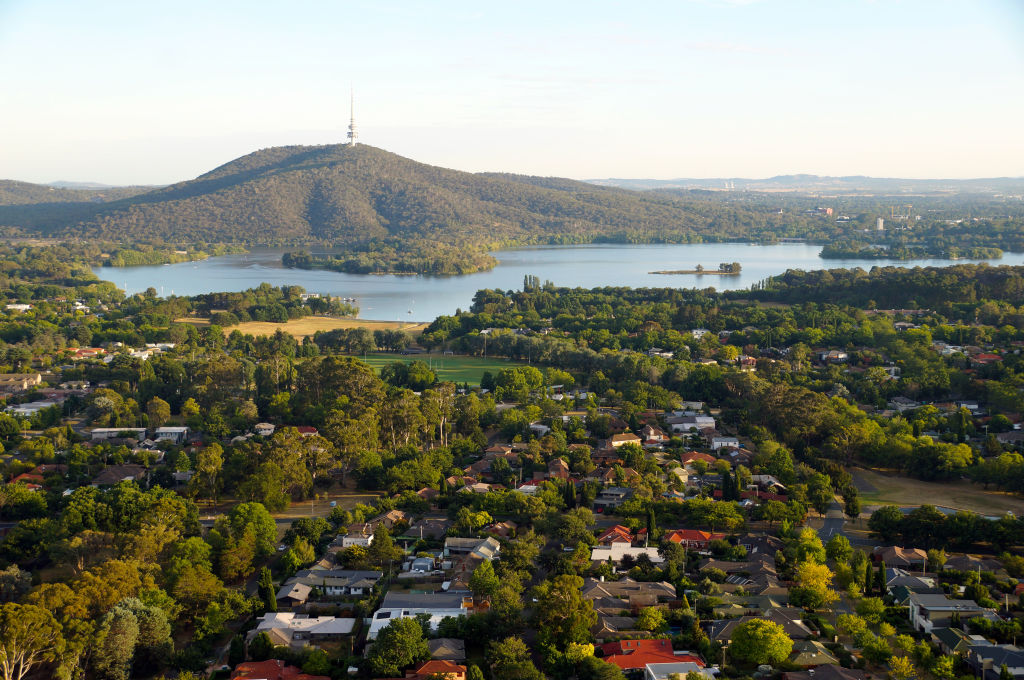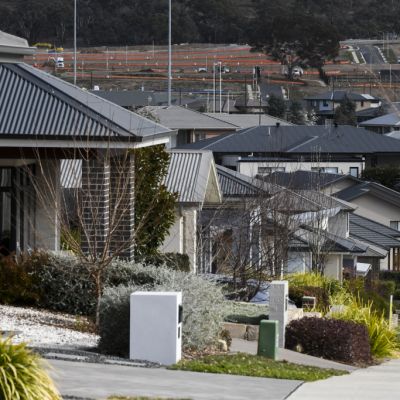Canberra house prices record strongest annual growth in three years: Domain House Price Report

Canberra’s property market has weathered the coronavirus pandemic and in the three months to September 2020, the capital’s median house prices recorded the strongest annual growth in three years, according to new data.
The Domain House Price Report for the September quarter showed Canberra’s house prices increased by 9.8 per cent year-on-year to $817,810. This was a quarterly growth of 3.5 per cent.
Domain senior research analyst Nicola Powell said the city’s annual growth was its strongest since early 2017 and looking back on the previous five years, Canberra’s house prices have been in a healthy position.
| Median house prices across Australia’s capital cities | ||||
| Capital City | Sep-20 | Sep-19 | QoQ | YoY |
| Sydney | $1,154,406 | $1,080,996 | 1.2% | 6.8% |
| Melbourne | $875,980 | $862,063 | 0.0% | 1.6% |
| Brisbane | $596,316 | $574,838 | 0.4% | 3.7% |
| Adelaide | $564,927 | $529,164 | 2.8% | 6.8% |
| Canberra | $817,810 | $745,004 | 3.5% | 9.8% |
| Perth | $534,336 | $521,911 | 0.5% | 2.4% |
| Hobart | $555,754 | $480,429 | 6.9% | 15.7% |
| Darwin | $539,463 | $503,214 | 6.6% | 7.2% |
“Since 2015, house prices have risen 29.6 per cent, making Canberra the second best performer of all the capital cities during this time, behind only Hobart,” Dr Powell said.
When looking at the unit market, prices dropped by 2.6 per cent year-on-year to $447,143. This was a quarterly decline of 2.1 per cent.
“Unit prices have underperformed compared to houses, increasing 6.1 per cent over the past five years. Weak unit conditions across other capital cities have resulted in Canberra providing the fourth-strongest growth,” she said.
| Median unit prices across Australia’s capital cities | ||||
| Capital City | Sep-20 | Sep-19 | QoQ | YoY |
| Sydney | $732,423 | $702,237 | -0.2% | 4.3% |
| Melbourne | $536,659 | $522,123 | -0.1% | 2.8% |
| Brisbane | $383,585 | $408,417 | 1.7% | -6.1% |
| Adelaide | $331,553 | $316,460 | 4.4% | 4.8% |
| Canberra | $447,143 | $458,996 | -2.1% | -2.6% |
| Perth | $335,869 | $351,810 | 0.7% | -4.5% |
| Hobart | $384,672 | $390,461 | -9.1% | -1.5% |
| Darwin | $326,268 | $302,679 | 4.5% | 7.8% |
Senior lecturer at the Canberra School of Politics, Economics & Society John Hawkins said Canberra’s strong house price growth was a reflection of its economic position.
“The underlying economic conditions are just better in Canberra than the rest of the country. ACT’s unemployment rate is at 4 per cent, while across Australia it’s 7 per cent,” Dr Hawkins said.
“More than half of the jobs that were lost in April and May in the ACT because of COVID were regained by July.”
Buyers agent Claire Corby, of Capital Buyers Agency, said buyer demand had been high the entire year, with the pandemic only seeing a slight drop in buyer appetite between March and April.

“That demand certainly picked up by May once people realised that Canberra was able to manage and adapt to the conditions of the pandemic,” Ms Corby said.
What’s driving that growth? Investors and families upsizing, she said.
“We’re seeing more investors return to the market. They are seeing that Canberra’s property market is a resilient one that doesn’t tend to have that volatility that other cities do. It’s a stable market and a sensible place to park their funds.
“There are families who are also looking to secure a house before the school term starts next year. More and more buyers are acting out of the fear of missing out … there just isn’t enough supply,” she said.
When looking at house prices across Canberra regions, all regions except for the Inner South recorded an increase year-on-year and over the quarter.
Houses in Woden Valley saw the biggest increase over the year, up 13.3 per cent to $950,000. This was a quarterly increase of 5.3 per cent.
This was followed by Weston Creek, up 11.4 per cent year-on-year to $775,000, an increase of 3.7 per cent over the quarter; and Tuggeranong, up 11 per cent year-on-year to $654,750, an increase of 3.4 per cent over the quarter.
| Median house prices across Canberra regions | ||||
| Region | Sep-20 | Sep-19 | QoQ | YoY |
| Belconnen | $645,500 | $610,000 | 2.5% | 5.8% |
| Gungahlin | $725,000 | $670,000 | 0.7% | 8.2% |
| Inner North* | $950,000 | $880,000 | 4.4% | 8.0% |
| Inner South | $1,282,500 | $1,300,000 | -3.2% | -1.3% |
| Tuggeranong | $654,750 | $590,000 | 3.4% | 11.0% |
| Weston Creek | $775,000 | $696,000 | 3.7% | 11.4% |
| Woden Valley | $950,000 | $838,500 | 5.3% | 13.3% |
| Greater Queanbeyan | $650,000 | $590,250 | 2.4% | 10.1% |
Ms Corby said first-home buyers and families had pushed these prices up, particularly because these areas “represent good value for money given they are on a good-sized block, in a central location”.
Dr Powell said several first-home buyers were looking to get their foot in the market and take advantage of the incentives available to them, including stamp duty abolition on new and existing properties.
Houses in the Inner South declined by 1.3 per cent year-on-year to $1,282,500, down 3.2 per cent over the quarter.
“The Inner South saw substantial growth prior to the pandemic compared to the other regions. These latest figures indicate that there may be further weakness ahead and if there is going to be weakness, it’s normally in the upper-end of the market,” Dr Powell said.
In the unit market across the regions, Tuggeranong saw the biggest increase year-on-year up 4.7 per cent to $445,000, a figure that remained unchanged over the quarter.
This was followed by Gungahlin, up 4.6 per cent year-on-year to $434,250, a slight decline of 0.6 per cent over the quarter.
| Median unit prices across Canberra regions | ||||
| Region | Sep-20 | Sep-19 | QoQ | YoY |
| Belconnen | $430,000 | $415,000 | 0.5% | 3.6% |
| Gungahlin | $434,250 | $415,000 | -0.6% | 4.6% |
| Inner North | $499,900 | $501,250 | 4.8% | -0.3% |
| Inner South | $520,278 | $529,000 | 1.0% | -1.6% |
| Tuggeranong | $445,000 | $425,000 | 0.0% | 4.7% |
| Weston Creek | $460,000 | $479,900 | -1.1% | -4.1% |
| Woden Valley* | $467,500 | $476,000 | -2.6% | -1.8% |
| Greater Queanbeyan | $265,000 | $255,000 | -4.3% | 3.9% |
Ms Corby described the unit market as “saturated”, noting that the over-supply of units coming to the market will take some time to be picked up by buyers.
Dr Powell said the capital’s success in containing the spread of the virus, coupled with historically low interest rates, income support measures, mortgage repayment holidays and financial incentives had supported the city’s prices.
“We’ll see house price weakness in the larger cities but the smaller cities will benefit from these incentives, particularly the low interest rates and potentially future lower interest rates, including Canberra,” she said.
We recommend
We thought you might like
States
Capital Cities
Capital Cities - Rentals
Popular Areas
Allhomes
More








